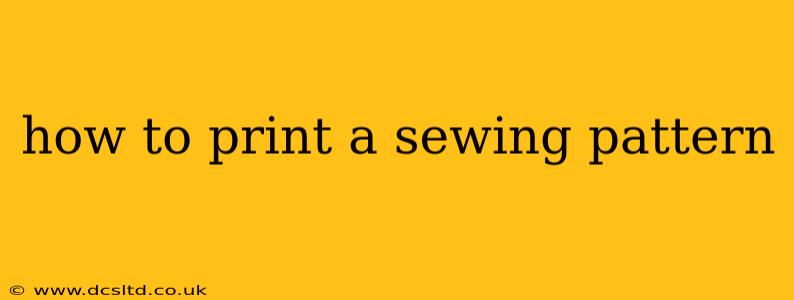Printing sewing patterns can seem daunting, but with the right approach, it's a straightforward process. This guide covers everything from choosing the right file to assembling your printed pattern pieces, ensuring a successful sewing project. We'll also address common questions and troubleshooting tips.
Choosing the Right Pattern File
Before you even think about printing, ensure you've downloaded the correct file type. Most digital sewing patterns come as PDF files. These files often include multiple pages, sometimes requiring specific printing settings to ensure accurate scaling.
Important Considerations:
- Check the pattern instructions: The pattern designer will usually provide detailed instructions on printing, including scaling settings, and whether the pattern requires tiling (printing across multiple pages). Follow these instructions meticulously; they are crucial for accuracy.
- Software Compatibility: Make sure your PDF reader (like Adobe Acrobat Reader) is updated. Older versions can sometimes cause printing issues.
Preparing Your Printer and Computer
Getting your printer and computer ready is crucial for a successful print job. This helps avoid common problems like misaligned pattern pieces.
- Printer Paper: Use plain, standard-weight printer paper (20-24 lb). Heavier paper can cause jams, while thinner paper may tear. Avoid using glossy or textured paper, as it can affect the ink adhesion and lead to misalignment.
- Print Settings: Select “actual size” or “100%” scaling in your printer settings. Do not select "fit to page," which will distort the pattern. This is perhaps the single most important setting to get right.
- Test Print: Always print a test page, preferably one with registration marks (small squares often found on the pattern sheet edges). These marks help to verify scaling and alignment. Check carefully to ensure that the test print is the correct size. If it's not, adjust your printer settings accordingly.
Assembling Your Printed Pattern
Once you have printed all the pages, assembling the pattern is the next step. This process often involves taping or gluing the pages together to create the full-sized pattern pieces.
- Accurate Alignment: Carefully align the printed pages using the registration marks or numbered edges. Slight misalignment can significantly affect the garment's fit. Use clear tape to securely join the pattern pieces. Avoid using glue, as it can leave residue that affects the fabric.
- Cutting Your Pattern: Once assembled, carefully cut out the pattern pieces, following the cutting lines. Remember to check the pattern instructions for any specific instructions on cutting the pattern.
How to Print a Sewing Pattern on Multiple Sheets?
Many sewing patterns are designed to print across multiple sheets. This tiling ensures the pattern maintains its correct proportions even when printed on regular-sized paper. Most digital patterns provide clear instructions on how to tile the pattern pieces. If not, look for registration marks or page numbers to accurately arrange the printed sheets. The instructions will also usually show how these pages should fit together. Use clear tape to join them, ensuring perfect alignment before you cut the pattern.
What if My Printed Pattern Is Too Small or Too Large?
If your printed pattern is too small or too large despite using the correct print settings, there could be multiple issues:
- Incorrect Printer Driver: Update your printer driver. Sometimes, outdated drivers can cause scaling problems.
- Incorrect PDF Reader: An outdated PDF reader could misinterpret the scaling settings. Try using a different reader (Adobe Acrobat Reader is recommended).
- Paper Size Settings: Ensure your printer is correctly configured for the paper size you are using.
Troubleshooting Tips
- Blurry Print: Make sure your printer cartridges are full and that your printer has sufficient ink.
- Missed Sections: If parts are missing or distorted, re-check your printing settings and print again.
- Misaligned Pages: Double-check alignment before taping the pages together. Use a ruler or a clear grid to ensure accurate alignment.
Printing a sewing pattern doesn't have to be stressful. By following these steps and paying close attention to detail, you can easily create accurate and ready-to-use patterns for your next sewing project. Remember, precision is key!
